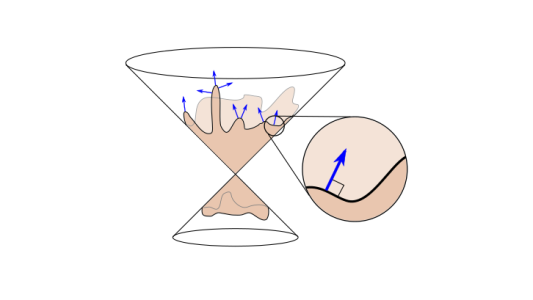As part of our series of research articles deliberately focusing on the rigour and intricacies of mathematics and its problems, Oxford Mathematician Eduardo Casali discusses his work.
This work [1], done with my collaborator Piotr Tourkine, is our attempt to understand the origin of some recent constructions in theoretical physics and how they fit into more standard techniques. These constructions go by the name of ambitwistor strings [2], named so because they combine elements of classical twistor theory and string theory. As in usual string theory, it is a theory of maps from Riemann surfaces into some target space, usually spacetime, taken to be $\mathbb{R}^D$ where the dimension $D$ depends on which flavour of string theory one is studying. In the case of the ambitwistor string target space is a generalization of twistor space to arbitrary dimensions called ambitwistor space. This can be defined as the space of complex null geodesics of complexified spacetime. For example, the ambitwistor space of $\mathcal{M}=\mathbb{C}^D$ is given by the quotient $\mathbb{A}=T^*\mathcal{M}//\{P^2=0\}$. The ambitwistor string is then a theory of holomorphic maps from Riemann surfaces into $\mathbb{A}$.
Following the rules of string theory, one can allow certain kinds of singularities on the Riemann surface such that these surfaces now have moduli and the string theory gives an integral over the corresponding moduli space. These integrals correspond to scattering of particles in a theory with an infinite spectrum of massive particles. To obtain results related to standard quantum field theories a low-energy limit must be taken, which corresponds to $\alpha'\rightarrow0$ where $\alpha'$ is the inverse of the string tension. In terms of the moduli space integral this limit is subtle, breaking the integral into several smaller pieces akin to Feynman diagrams. But surprisingly, in the ambitwistor string no limit needs to be taken. The moduli space integral already gives the result in the $\alpha'\rightarrow0$ limit. This is possible since the integral in this case localizes to the solution set of a set of equations called the scattering equations[3]. These equations had previously been found in the opposite limit of the string, the high-energy limit $\alpha'\rightarrow\infty$[4], so their appearance in the ambitwistor string is a bit of a puzzle. Another related puzzle was how the ambitwistor string fits into the framework of conventional string theory. It shares several similarities, both in its set-up and in the calculations coming from it, but a naive attempt to take the $\alpha'\rightarrow0$ limit gives a very different result.
It is here that our recent work comes in. We showed how the ambitwistor string model can be derived from a more fundamental model, the null string. This third string theory is obtained by taking the $\alpha'\rightarrow\infty$ limit in the original string and then quantising. By making specific choices in the null string one can show that it coincides with the ambitwistor string. With this interpretation of the ambitwistor string in hand we can make sense of some of its more puzzling characteristics. First, it gives a rationale for the appearance of the scattering equations in what seemed to be the complete opposite limit. It also helps connecting the ambitwistor string to usual string theory and shows promise in generalizing the ambitwistor string to describe more general theories. But more importantly, it opens a new way in which we can approach it. By making different choices when setting up the null string, which don't affect the end result, we hope to obtain new scattering formulas and a new understanding of the geometric role played by the scattering equations and the moduli space of Riemann surfaces in these formulas. Finally, this might also shed light on the old problem of how the spacetime equations of motions are codified into ambitwistor space. An answer to this was given by LeBrun and Mason [5], but their construction is quite different from what the ambitwistor string seems to imply. That is, that the equations of motion should be somehow codified into embeddings of Riemann surfaces into ambitwistor space.
[1] E. Casali and P. Tourkine, “On the null origin of the ambitwistor string,” JHEP 11 (2016).
[2] L. Mason and D. Skinner, “Ambitwistor strings and the scattering equations,” JHEP 07 (2014).
[3] F. Cachazo, S. He, and E. Y. Yuan, “Scattering of Massless Particles in Arbitrary Dimensions,” Phys. Rev. Lett. 113 no. 17, (2014).
[4] D. J. Gross and P. F. Mende, “The High-Energy Behavior of String Scattering Amplitudes,” Phys. Lett. B197 (1987) 129–134.
[5] C. LeBrun, “Spaces of complex null geodesics in complex-Riemannian geometry,” Trans. Amer. Math. Soc. 278 no. 1, (1983) 209–231.


